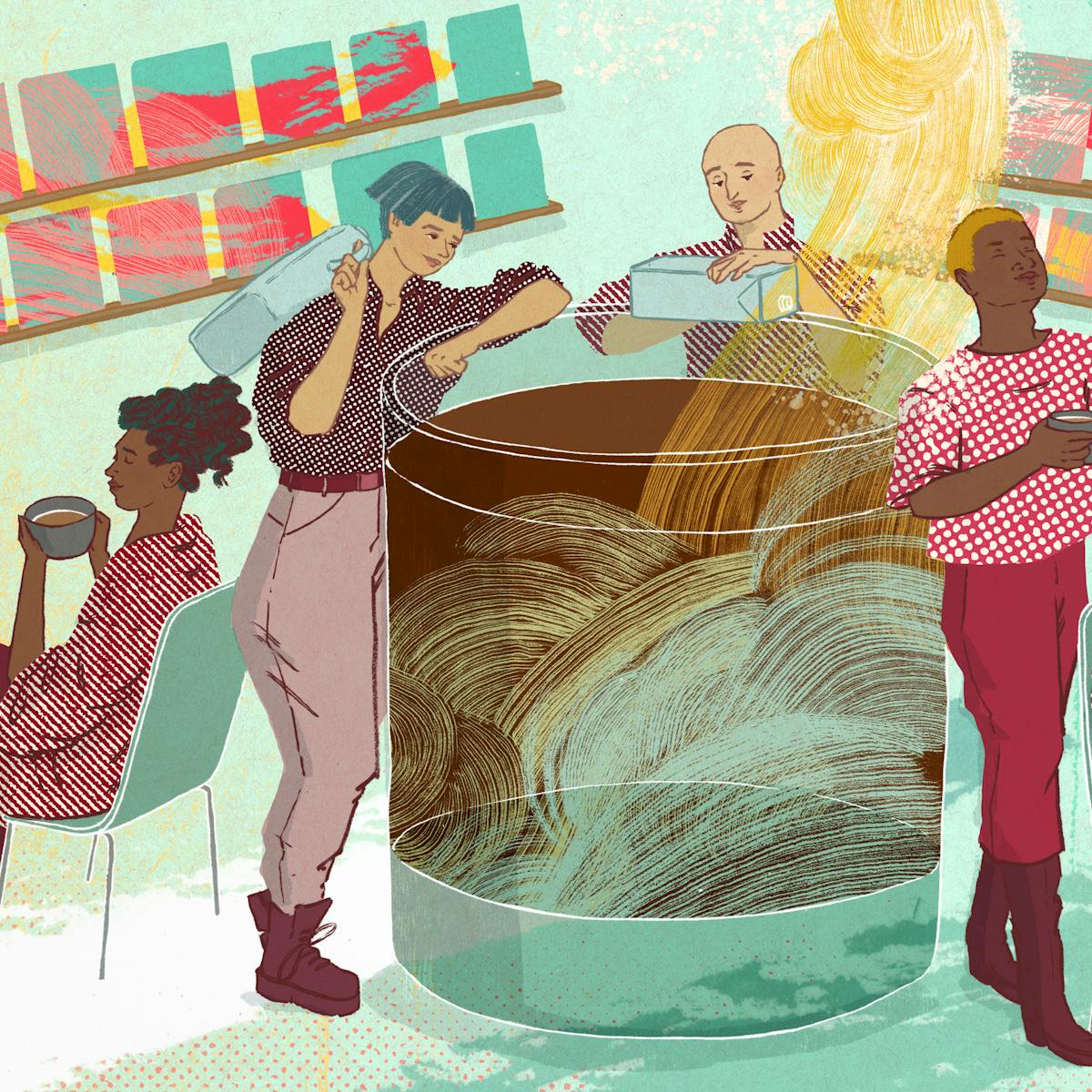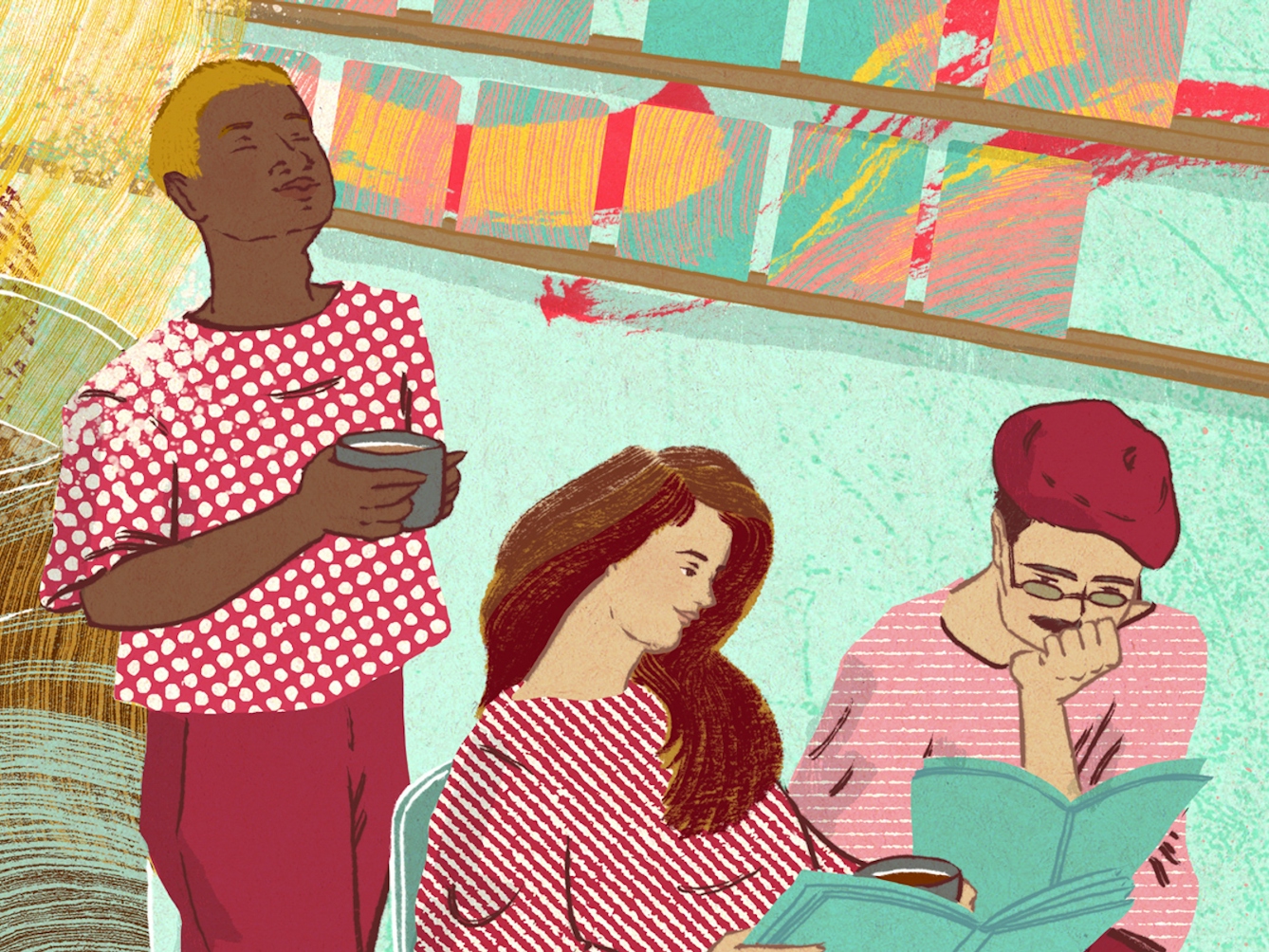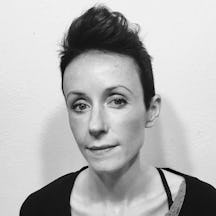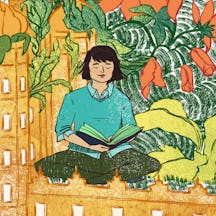Oat milk is the ‘alt-milk’ du jour at the local coffee shop. To the LGBTQIA+ community in London, the switch from cow’s milk to vegan alternatives is as much about building communities of care as it is about environmentalism.
Queer cafés and gay mylk
Words by Holly Reganartwork by Cat O’Neilaverage reading time 8 minutes
- Article

Peering over the rim of my mug, a silly grin spreads across my face as I survey the crowd. A moustachioed person in round spectacles and a perfectly poised beret; black-clad teens locked in lively debate over stacks of books on queer theory; a long-haired couple defying the soggy damp in short skirts, pecking at opposingly positioned laptops.
This is the queer café, these are my people – and, guaranteed, almost all of them are drinking oat-milk flat whites.
“We overwhelmingly sell more oat milk than regular, even though there’s a 20p surcharge,” says Alfonzo Sieveking, bookshop manager at the Common Press, a queer-owned, intersectional bookstore and café in London’s Brick Lane neighbourhood.
The location draws a cross-section of customers: tourists and locals from the LGBTQIA+ community, as well as straight road workers on their break and people heading home from the office. You can spot the latter groups right away. Their tell, according to Sieveking: they order dairy milk.
More than just places to caffeinate, socialise and work, queer cafés are hubs for community health. They host events that range from an STI screening clinic, to yoga and meditation classes, to writers’ circles and workshops on consent. Artwork, books and products by queer makers adorn the walls and are offered for sale. Here, ‘alternative’ is the norm.
‘Oat milk is gay’
Plant-based cuisine and queer identity have always intersected. Either can make you a target – I’ve been harassed more often (though less viciously) for my dietary choices than being queer and nonbinary – but they also lay foundations for community.

“Peering over the rim of my mug, a silly grin spreads across my face as I survey the crowd.”
In both instances, coming out is required. Asserting your identity may provoke strong and surprising reactions from friends and family: “Will you get enough protein? What if you want to have kids? How will we eat together? Why do I have to stop calling you my sister?” Finding the place where you can actually relax, surrounded by your people with your choices on the menu, the hypervigilance required to explain and affirm your autonomy can finally drop.
“There is a shared set of slogans and actions, beliefs and values, and some of that manifests materially,” Sieveking says, from queer publishers that use recycled paper to the popularity of vegan cookbooks and drink orders at the shop. “Sometimes the connections are obvious; other times, you don’t notice them until… you’re ordering ten times more oat than regular milk.”
Similarly, says Daniel Fico, owner of queer coffee shop and hot-desking space Atlas Grinds in Stoke Newington, at least half of all sales are oat milk, followed by soy, coconut and almond, with cow coming last.
Of course, there is no monolithic queer community; it’s a smattering of diverse, distinct subcultures. Not everyone likes, or can tolerate, oat milk – while oats are gluten-free, many oat milks are cross-contaminated with gluten. As someone with coeliac disease, Kit, a queer Londoner and coffee lover, bemoans its ubiquity, saying they feel more alienated now than before the trend exploded.
But for some, oat milk has become a light-hearted signifier for queerness in the same way that making almond milk has been termed a “gay right of passage”.
On TikTok, the hashtag #oatmilkisgay has nearly 100 million views. In-jokes on the platform suggest oat-beverage orders can help you determine if your customer-crush is also queer. Some even playfully suggest non-oat milk orders are anti-allyship and claim surcharges on oat milk at cafés are homophobic. Meant to bond an online community through humour, these videos also speak to a broader connection between queer identities and veganism, one aligned with a holistic view of community care.
Interests have always intersected between various ‘countercultural’ groups. Some lesbians and members of the hippie movement in the 1960s, who shared concern for the environment, were collectively referred to as ‘granola’, opposing corporate food and limitless growth. The hippies also used the rainbow as a symbol of peace during protests and may have helped set legal precedent for gay marriage.
For some, oat milk has become a light-hearted signifier for queerness.
Concern for the most vulnerable remains endemic to the queer experience, from fighting for rights and protecting trans teens to sparing the lives of chickens and cows. A recent survey of UK vegan Facebook groups found that 66 per cent of members are LGBTQIA+.

“Sometimes the connections are obvious; other times, you don’t notice them until… you’re ordering ten times more oat than regular milk.”
“For me, there is something around anti-‘normativity’, anarchy and queerness,” says Belle, a 29-year-old queer woman. “Veganism fits in that box, so therefore, so does oat milk.”
Born this whey
One of the earliest (and only) acts of bodily sovereignty children can claim is what they eat and drink. I still recall the rush of empowerment when I decided, at a young age, to no longer eat beef.
While it has, mercifully, become less common for people to call sexual orientation and gender identity a “lifestyle choice”, vegetarianism and veganism is typically considered a matter of will, but I’m not sure I agree. In either case, you’re listening to what your body is telling you it needs to be healthy and fully expressed, and fiddling with the inputs and outputs of sensory experience until you end up with something that actually feels like you.
Once you’ve realised that you aren’t who you thought you were, interrogating everything from who you love to the biology you were born into, it’s not much of a stretch to switch to tofu. And after you’ve reclaimed your body as your own, maybe you think a little bit harder about what goes into it.
The queer community is used to providing its own healthcare, says Fico, after being left behind or even targeted by the medical and mental health system. Bars played crucial roles as community health centres during the HIV and AIDS crisis and the nascent movement for equality, back when the public still called it “gay rights”.
“Queers are born activists. This goes hand in hand with looking after the environment, your own health, and other people’s health,” says Fico. Besides, queer folks need a safe space to do all the regular-life things cisgendered, heterosexual people can do from anywhere, Fico adds, such as coworking. Any place can hang a rainbow flag, but community ownership fosters accountability; his new venue, House of Hades in Hackney, was almost entirely crowdfunded by queer patrons.
Can oat milk save our spaces?
Stoke Newington is neighbourhood with a historical lesbian presence. According to Fico, it used to be full of queer bars, but almost all have closed. In fact, nearly 60 per cent of London’s queer venues shuttered between 2006 and 2017, before the pandemic felled many more. It’s a trend rippling around the globe, and people’s very personhood is threatened when they close.

“And after you’ve reclaimed your body as your own, maybe you think a little bit harder about what goes into it.”
“We've done fundraisers for people's top surgeries; for [annual festival] Camp Trans… [and for] private parties and birthdays,” Fico says, but “the biggest struggle is getting people in. A lot of queers are not from well-off backgrounds. So they're definitely more conscious of where and how they spend money. And… with the living-costs crisis, our revenue has plummeted because people just can't afford to go out as much.”
Luckily, Common Press has never been busier, but Common Counter, its adjoining bar, closed in February 2023. The retail element likely helps: queer bookstores have been thriving in the UK since the pandemic. But perhaps it’s because more people feel welcome in a space that doesn’t revolve around alcohol. Common Press’s downstairs events space hosts up to 50 private events a month, during which the bookshop keeps the coffee flowing.
Sieveking also shares, “A lot of what we do here [Common Press] is oriented toward healthy living,” including HIV testing and early Covid-vaccine distribution for vulnerable populations. Many London cafés are only performatively welcoming, and few are queer-owned, Fico says, and asks: “Lots of people put a label on Google saying ‘LGBTQ-friendly’, but what do [they] do for the community?”
Only time will tell if oat milk’s cultural importance will help preserve these spaces. In the meantime, as Fico says, “We’ve introduced so many people who love working and collaborating together. That's what the community is all about.”
Whether it’s finally being able to settle enough to get some work done or making a connection that helps you change your body and your life, you’ll know you’ve found the place you belong when you look around and see yourself reflected, and they’ve already started making your oat-milk flat white when you walk in.
About the contributors
Holly Regan
Holly Regan is a writer, editor, and artist who covers the intersection of culture and consciousness-altering substances around the world. As a queer and gender-expansive person, they focus on the experiences of LGBTQIA+ and underrepresented people.
Cat O’Neil
Cat O’Neil is an award-winning freelance illustrator, specialising in editorial. She studied at the Edinburgh College of Art, graduating in 2011, and has lived in Hong Kong, London, Glasgow, Lyon and Edinburgh. Her clients include the New York Times, Washington Post, WIRED, LA Times, Scientific American, the Financial Times, the Guardian/Observer, Libération and more. Her work explores the use of visual metaphors to convey concept and narrative, and combines the use of traditional and digital mediums. Much of her recent work includes the creation of 3D paper sculptures, which are made in her studio in Edinburgh.

